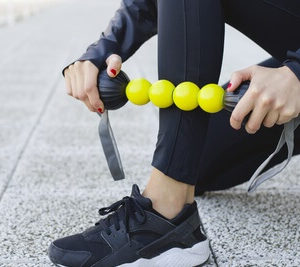Myofascial Release, How Does it Help?
What is Fascia and How does Myofascial Release Help?
Personal Trainers everywhere are currently hot on the Myofascial release bandwagon. However, how many people understand when it should be used and how it is properly done? The answer to these questions are wide and varied depending on with whom you discuss the topic. There are several areas to review in order that you truly understand the mechanics and methods that would work best.
What is Fascia?
Many of my personal training clients look puzzled when I ask them if they roll their muscles. We discuss how important it is, especially for those that are avid runners, endurance athletes or bodybuilders. Myofascia is a sheet or band of fibrous connective tissue that surrounds the muscles and other organs of the body. It holds muscles with similar functions together and allows free movement of the muscles to glide over one another. It contains nerves, blood and lymph vessels as well as filling the space between the muscles. Another primary function is acting as insulation for muscles fibers from one another’s electrical activity. Muscles have three different layers of Fascia (material that is akin to cellophane) with each providing a different function.
What is Myofascial Release?
Myofascial release is a therapeutic technique used by health care professionals such as physiotherapists and massage therapists. Myofascial massage is the rolling of the skin and muscle between the fingers to break down adhesions between the muscle, the fascia and the skin. This form of skin rolling massage can be extremely painful, since many nerve fibre endings rest between and among these structures. Hypothetically, myofascial pain differs due to its origins from trigger points which are related to the stiff, anchored adhesions areas between the muscle, the myofascial tissue. Generally, therapists find the source hard to pinpoint due to the fact it is difficult to identify the origin.
Self Directed Myofascial Release
Myofascial release can be performed on your own at home or in the gym (under the supervision of your therapist or elite personal trainer). Please ensure that your fitness professional has proper training in this technique and gives you specific instructions. When doing this myofascial release at home you can use fingers, a foam roller, ball or rolling stick on the tight muscle to break down adhesions.
It is important to note that when rolling, you avoid putting direct pressure on your joints or bursa sacs. Discuss important areas to avoid with your personal trainer. Other things to avoid would be rolling areas that are still in an acute phase of inflammation, rolling too fast, spending too much time on one area, rolling with poor posture and rolling directly on the spine (especially in the lower back area with an extended spine or arched back).
In order to create lasting effects when foam rolling (or using a stick or ball) remember to roll correctly, this means you should slow down and move one inch per second. Moving slowly, will you give your muscles time to adjust to the pressure and relax. Foam rolling should feel mildly uncomfortable, not painful, so stop if your pain starts to increase. When done properly you should get a “melting” feeling which means the muscle is relaxing (and the pain should decrease). You will find, if you are rolling too vigorously or startt quickly, that you will get the opposite effect and will feel your muscles stiffen. Always remember to start gently and then increase pressure as tolerated. You will find that the best results for long term effects entails you stretching several times on a daily basis.
includes some form of foam rolling
Discuss a flexibility program that includes some form of rolling with your personal trainer. Your trainer will establish if a foam roller, stick or ball would be most practical/relevant for your particular circumstance. Should you be starting with a new personal trainer, then ensure that he/she is certified with an appropriate governing body and has experience developing advanced flexibility programs.
Cathie Glennon, BCRPA-SFL
https://fitness.mercola.com/sites/fitness/archive/2015/02/27/5-foam-rolling-mistakes.aspx
https://www.mayoclinic.org/diseases-conditions/back-pain/expert-answers/myofascial-release/faq-20058136
Infofit Fitness Theory Manual Section 4; The Muscular System – Overview of Connective Tissue, Page 70


